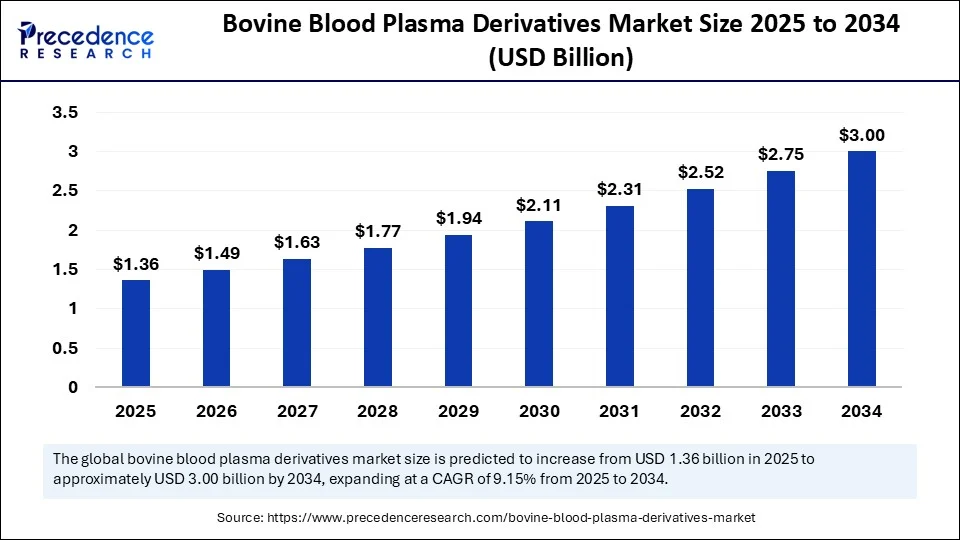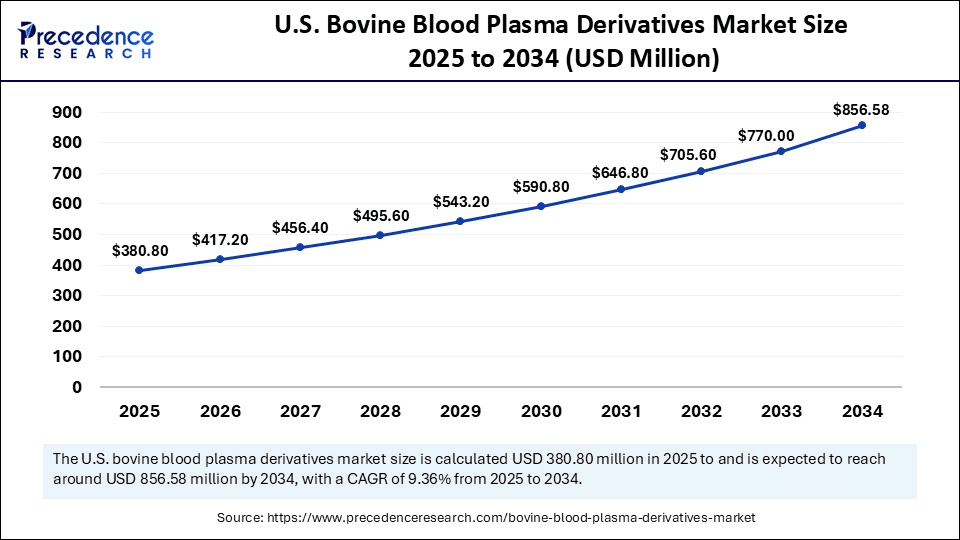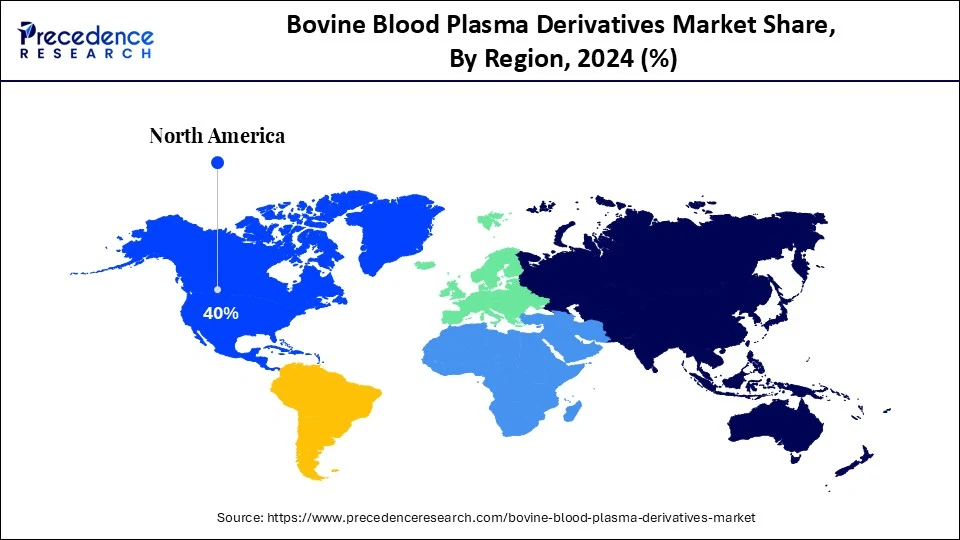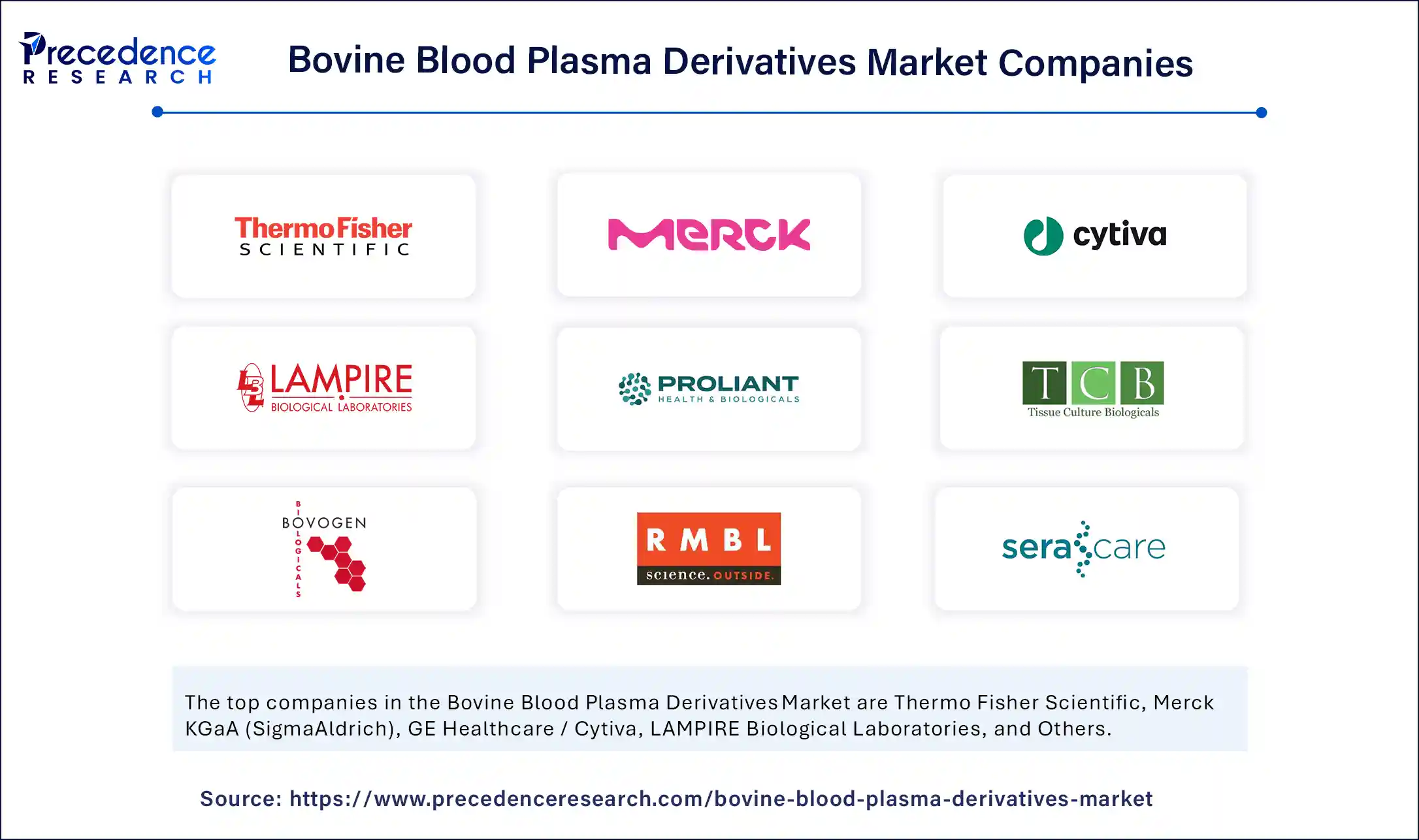List of Contents
Bovine Blood Plasma Derivatives Market Size and Forecast 2025 to 2034
The global bovine blood plasma derivatives market size was estimated at USD 1.25 billion in 2024 and is predicted to increase from USD 1.36 billion in 2025 to approximately USD 3.00 billion by 2034, expanding at a CAGR of 9.15% from 2025 to 2034. The market is experiencing substantial growth due to the increasing use of bovine blood plasma derivatives in the production of high-protein supplements, animal feeds, and pharmaceuticals. Advancements in processing and purification techniques and a growing focus on animal health are expected to further drive market growth.

Bovine Blood Plasma Derivatives Market Key Takeaways
- In terms of revenue, the global bovine blood plasma derivatives market was valued at USD 1.25 billion in 2024.
- It is projected to reach USD 3.00 billion by 2034.
- The market is expected to grow at a CAGR of 9.15% from 2025 to 2034.
- North America dominated the global market with the largest share of 40% share in 2024.
- Asia Pacific is anticipated to grow at the fastest CAGR from 2025 to 2034.
- By derivative type, the fetal bovine serum (FBS) segment held the major market share of 25% in 2024.
- By derivative type, the immunoglobulin segment is projected to grow at a significant CAGR between 2025 and 2034.
- By application, the pharmaceuticals segment captured the biggest market share of 28% in 2024.
- By application, the cell culture/biotechnology segment is expected to grow at a significant CAGR over the projected period.
- By end user, the hospitals and clinics segment generated the largest market share of 30% in 2024.
- By end user, the research laboratories segment is anticipated to grow at a significant CAGR from 2025 to 2034.
How Can AI Impact the Bovine Blood Plasma Derivatives Market?
Artificial intelligence (AI) is transforming the bovine blood plasma derivatives market by improving product quality, streamlining manufacturing processes, and forecasting market trends. AI systems analyze large datasets of animal health information, including biometric data, behavior patterns, and environmental factors, to predict and prevent potential health problems in donor animals. This proactive approach helps produce high-quality blood plasma with minimal contamination or variation. AI is also integrated into precision livestock farming, enabling real-time monitoring of animal health, behavior, and feed intake. It further optimizes stages of plasma processing, such as separation, purification, and formulation, increasing efficiency, reducing waste, and ensuring higher product purity.
U.S. Bovine Blood Plasma Derivatives Market Size and Growth 2025 to 2034
The U.S. bovine blood plasma derivatives market size was exhibited at USD 350.00 million in 2024 and is projected to be worth around USD 856.58 million by 2034, growing at a CAGR of 9.36% from 2025 to 2034.

What Made North America the Dominant Region in the Bovine Blood Plasma Derivatives Market in 2024?
North America dominated the global bovine blood plasma derivatives market with major share of 40% in 2024. This is due to its well-established healthcare infrastructure, with hospitals and clinics that adopt these derivatives readily, a high volume of surgical procedures, and a strong biopharmaceutical industry. The region is home to major market players, including LAMPIRE Biological Laboratories, Proliant Biologicals, Sigma-Aldrich, Thermo Fisher Scientific, Rocky Mountain Biologicals, and Bovogen Biologicals, bolstering innovations in the market. There is a strong focus on R&D, boosting the demand for these derivatives in cell culture media and diagnostics. Favorable regulatory environments, public-private partnerships, and advances in processing and sourcing are also strengthening North America's leadership.
- In March 2025, Dr. John Majercak, Head of Antibody Discovery at LAMPIRE Biological Laboratories, highlighted their cutting-edge methods in monoclonal antibody development. He discussed their specialized antibody products, including Llama vHH nanobodies, Bovine ultra-long CDR3 Picobodies, and Rabbit Monoclonals, showcasing the latest breakthroughs in antibody therapeutics.
(Source: https://www.lampire.com)
U.S. Bovine Blood Plasma Derivatives Market Trends
The U.S. plays a significant role in the market. The U.S. is a leading exporter of plasma, meeting a large portion of the world's needs. The country also boasts an advanced healthcare infrastructure and a robust R&D ecosystem, supporting market growth. Rising investments in biopharmaceutical research & development further boost market growth. Additionally, being a major producer of bovine blood plasma with facilities approved by the U.S. Department of Agriculture ensures the production of high-quality plasma, which fuels the market growth.

What Makes Asia Pacific the Fastest-Growing Region in the Bovine Blood Plasma Derivatives Market?
Asia Pacific is expected to grow at the fastest rate in the coming years. This is mainly due to the rise in chronic diseases, an growing geriatric population, and increased investment in healthcare infrastructure. As diseases like hemophilia, immunodeficiency disorders, and liver diseases become more common, the need for plasma-derived therapies grows, especially in countries like Japan, China, and South Korea. Governments are actively promoting innovative therapies through policies such as reimbursement programs, funding for plasma collection centers, and streamlining export processes for derivatives like cattle protein and serum. Private companies are also ramping up R&D investments in biopharmaceuticals, including bovine blood plasma derivatives, driving innovation and growth.
- In May 2023, PlasmaGen Biosciences opened a new manufacturing plant in Kolar, Bengaluru, dedicated to blood plasma-derived protein therapeutics. This facility boasts the largest R&D infrastructure and quality control labs in the Indian blood plasma industry, aiming to produce products such as albumin, immunoglobulins, and coagulation factors.(Source: https://www.prnewswire.com)
India Bovine Blood Plasma Derivatives Market Trends
India plays a major role in the market. The growth of the market in the country is primarily fueled by the growing pharmaceutical and biotechnology industries. The domestic production capabilities are rising with investments in R&D. There is a high demand for specialized plasma products like immunoglobulins. Technological advances in processing and purification methods, as well as rising healthcare and biotech R&D activities, contribute to market growth in India.
Why Europe Considered a Notable Region in the Bovine Blood Plasma Derivatives Market?
Europe is expected to grow at a notable rate over the forecast period, driven by increasing demand for immunoglobulin derivatives, fibrinogen, and other plasma-derived products. Advances in purification technologies, expanding research applications, and the rising prevalence of chronic illnesses contribute to regional market growth. Additionally, regional initiatives aimed at self-sufficiency in plasma fractionation and bolstering domestic production are significant factors. Improved purification techniques have enhanced the quality and efficiency of these derivatives, increasing their appeal. The increased healthcare expenditure further supports market growth.
What Factors Contribute to the Bovine Blood Plasma Derivatives Market within the Middle East & Africa?
The Middle East & Africa is likely to experience significant growth, fueled by increased awareness of health & wellness, advancements in biotechnology, and rising demand for functional ingredients in food and feed. While specific government initiatives in the region are not detailed, broader investments in animal husbandry and biotech infrastructure are contributing to market growth. The rising use of bovine-derived blood plasma as functional ingredients in animal nutrition further supports regional market growth.
Market Overview
The bovine blood plasma derivatives market includes protein-based and bioactive components extracted from bovine blood plasma, such as fetal bovine serum (FBS), serum albumin, immunoglobulins, fibrinogen, thrombin, transferrin, and newborn calf serum. These derivatives are used across cell culture/biotechnology, pharmaceuticals, diagnostics, animal feed, cosmetics, and veterinary medicine. Market demand is driven by growing biopharma research and development, cell culture expansion, food and feed innovation, increasing demand for animal-derived proteins, regenerative medicine, diagnostic assay development, and advancements in biotechnology.
What are the Key Trends in the Bovine Blood Plasma Derivatives Market?
- Rising Prevalence of Chronic Diseases: The increasing prevalence of chronic diseases demands the development of advanced therapeutics, especially in pharmaceuticals and diagnostics, which boosts the demand for plasma-derived products.
- Advancements in Biotechnology: Advances in biotechnology, such as improved protein purification techniques like ion-exchange and affinity chromatography, along with new processing methods like ultrafiltration, are enhancing the efficiency, purity, and availability of bovine plasma derivatives.
- Expanding Biopharmaceutical Industry: The growth of the biopharmaceutical industry is driven by the rising number of surgical procedures, increased prevalence of bleeding disorders, and advancements in recombinant thrombin technology, all of which significantly boost market demand.
- Increasing Research and Development Funding: Rising investments in research and development are leading efforts to explore new applications and improve existing plasma products. Ongoing R&D in specialized plasma fractions and applications is further expanding the market.
Market Scope
| Report Coverage | Details |
| Market Size by 2034 | USD 3.00 Billion |
| Market Size in 2025 | USD 1.36 Billion |
| Market Size in 2024 | USD 1.25 Billion |
| Market Growth Rate from 2025 to 2034 | CAGR of 9.15% |
| Dominating Region | North America |
| Fastest Growing Region | Asia Pacific |
| Base Year | 2024 |
| Forecast Period | 2025 to 2034 |
| Segments Covered | Derivative Type, Application, End User, and Region |
| Regions Covered | North America, Europe, Asia-Pacific, Latin America, and Middle East & Africa |
Market Dynamics
Drivers
Increasing Demand for Animal Protein and Meat Products
The primary driver in the bovine blood plasma derivatives market is the increasing demand for animal protein and meat products. This significantly creates the need for bovine blood plasma derivatives in animal feed and nutrition. As the global demand for animal protein increases, so does the need for bovine blood plasma as a protein-rich ingredient in animal feed. Additionally, bovine blood plasma is processed into a highly digestible protein source called plasma powder, which is used as a feed additive to improve animal health and performance. This includes enhancing feed palatability, promoting gut health, and improving meat quality.
Increasing Use in Pharmaceuticals
The increasing use of bovine blood plasma derivatives in the pharmaceutical sector drives the growth of the market. These derivatives are essential components in the production of various drugs, such as vaccines. They are also used as therapeutic agents. As the global demand for pharmaceuticals rises, so does the need for bovine-derived plasma blood products. The growing aging population and increasing healthcare spending further propel the growth of the market.
Restraint
Strict Regulations and Concerns about Disease Transmission Risks
The main restraints in the bovine blood plasma derivatives market are strict regulations and ethical concerns regarding the production and use of animal-derived products. Moreover, concerns about disease transmission risks hamper the growth of the market. Bovine-derived products carry a risk of transmitting diseases from bovine to humans, leading to strict regulations, especially regarding the origin of the products and their use in food and pharmaceuticals during collection, processing, and distribution, which can increase costs and complexity. The risk of zoonotic diseases transmitted via bovine blood plasma present significant challenges. These issues require robust quality assurance systems, traceability, and transparent communication from manufacturers.
Opportunity
Expanding Applications Within the Biopharmaceutical Industry and Regenerative Medicine
The key future opportunity in the bovine blood plasma derivatives market lies in expanding applications within the biopharmaceutical industry and regenerative medicine, particularly for therapies addressing immune deficiencies, coagulation disorders, and wound healing. Research and development efforts are focused on discovering new therapeutic uses for these derivatives. Additionally, bovine thrombin, a key derivative, is utilized in regenerative medicine for its ability to promote hemostasis and facilitate wound healing. It is also incorporated into scaffolds for tissue regeneration, potentially accelerating healing and increasing demand in procedures such as cardiovascular, orthopedic, and general surgeries.
Derivative Type Insights
What Made Fetal Bovine Serum (FBS) the Dominant Segment in the Bovine Blood Plasma Derivatives Market in 2024?
The fetal bovine serum (FBS) segment dominated the market with the biggest share of 25% in 2024. This is mainly due to its superior growth-promoting properties and widespread use in cell culture research and pharmaceutical manufacturing, especially for vaccines and cell-based therapies. FBS contains high levels of growth factors, hormones, and nutrients that support cell growth and proliferation in vitro. It also has low levels of antibodies and growth-inhibiting components, making it suitable for cell culture. While FBS offers significant advantages, its high cost and potential variability and contamination lead to research into serum-free alternatives that support various cell types, making it a versatile option for research and biomanufacturing.
The immunoglobulin segment is expected to experience the fastest growth in the upcoming period. This is primarily because of its critical role in boosting animal immunity and its applications in treating various diseases. This growth is further supported by increasing demand in animal health and human medicine, particularly for immune deficiencies and neurological disorders. Immunoglobulins, also known as antibodies, are crucial for protecting animals against pathogens like bacteria, viruses, and fungi. Their inclusion in animal feed and supplements helps improve overall health. Additionally, advances in plasma processing and purification technologies make it easier to isolate and purify immunoglobulins, resulting in more effective and readily available products.
Application Insights
How Does the Pharmaceuticals Segment Lead the Bovine Blood Plasma Derivatives Market in 2024?
The pharmaceuticals segment dominated the market with the largest share of 28% in 2024. This is because bovine-derived products are crucial in the production of drug formulation, vaccines, and cell culture, especially for therapeutic proteins and vaccines. Bovine blood plasma contains albumin and immunoglobulins, vital for stabilizing and formulating biopharmaceuticals such as therapeutic proteins and vaccines. Bovine plasma derivatives are also used in the production of vaccines, including viral vector vaccines, due to their ability to carry antigens and stimulate an immune response. These derivatives provide essential nutrients and support for cell growth during research and manufacturing, especially in biologics development.
The cell culture/biotechnology segment is expected to expand at the fastest CAGR during the forecast period, driven by its key role in advancing cell and gene therapies, drug discovery, and other bioproducts. Bovine blood plasma derivatives, such as albumin and other proteins, are essential elements in cell culture media used for growing and differentiating cells in developing cell and gene therapies. These derivatives are also critical raw materials in the creation of new drugs and biologics, including vaccines and other therapeutic proteins. The rising demand for biopharmaceuticals and other bioproducts fuels the need for large-scale biomanufacturing facilities.
End User Insights
Why Did the Hospitals & Clinics Segment Dominate the Bovine Blood Plasma Derivatives Market in 2024?
The hospitals & clinics segment maintained its dominance in the bovine blood plasma derivatives market with highest share of 30% in 2024. This leadership is driven by their crucial role in administering plasma-based therapies for various conditions and their advanced infrastructure, which allows for effective treatment. Hospitals are equipped with specialized equipment and skilled medical professionals to deliver these therapies efficiently. Moreover, bovine blood plasma derivatives, like thrombin, are also used in surgical settings to manage bleeding during and after procedures, further increasing their usage in hospitals.
The research laboratories segment is expected to grow at the highest CAGR over the projection period. This is mainly due to the increasing use of bovine-derived products in biomedical research, drug development, and diagnostics, especially in academic and industrial settings. The unique properties of these derivatives, particularly their high bioactive and protein content, make them essential for various research applications. Their ability to support cell growth, serve as delivery vehicles for drugs, and be key components in vaccine formulations adds to their value. Government and private initiatives are also enhancing research infrastructure and funding, resulting in increased research activity and higher demand for bovine blood plasma derivatives.
Bovine Blood Plasma Derivatives Market Companies

- Thermo Fisher Scientific
- Merck KGaA (SigmaAldrich)
- GE Healthcare / Cytiva
- LAMPIRE Biological Laboratories
- Proliant Biologicals
- Tissue Culture Biologicals
- Bovogen Biologicals
- Rocky Mountain Biologicals
- SeraCare (MP Biomedical)
- Kraeber & Co GmbH
- Auckland BioSciences Ltd.
- Atlanta Biologicals, Inc.
- Biowest (France)
- Lake Immunogenics, Inc.
- ExCell Bio
- Zhejiang Tianhang Biotechnology
- American Protein Company
- Serana, among others.
Recent Developments
- In November 2024, BioWest launched a new high-quality bovine serum designed for large-scale cell culture. It is derived from clotted whole blood collected aseptically from a fetus via cardiac puncture, following European regulations. This serum is premium, chosen for its excellent endotoxin, hemoglobin, and cell growth properties, ensuring reliable results in cell culture.(Source: https://biowest.net)
- In August 2023, Dyadic International, Inc. announced positive results from third-party testing of its animal-free recombinant serum albumin. Using proprietary filamentous fungal microbial protein production platforms, the company successfully developed stable cell lines to produce high levels of animal-free recombinant bovine serum albumin and recombinant human serum albumin, addressing challenges of gene expression for affordable, large-scale protein and enzyme production.(Source: https://dyadic.com)
Segments Covered in the Report
By Derivative Type
- Fetal Bovine Serum (FBS)
- Immunoglobulin
- Fibrinogen
- Serum Albumin (BSA)
- Newborn Calf Serum
- Thrombin
- Transferrin
- Others
By Application
- Pharmaceuticals
- Cell Culture / Biotechnology
- Diagnostic Industry
- Research & Development
- Food Industry
- Cosmetic Industry
- Others
By End User
- Hospitals & Clinics
- Research Laboratories
- Food Processing Companies
- Veterinary Clinics
- Other Users
By Region
- North America
- Europe
- Asia-Pacific
- Latin America
- Middle East & Africa
For inquiries regarding discounts, bulk purchases, or customization requests, please contact us at sales@precedenceresearch.com
Frequently Asked Questions
Ask For Sample
No cookie-cutter, only authentic analysis – take the 1st step to become a Precedence Research client